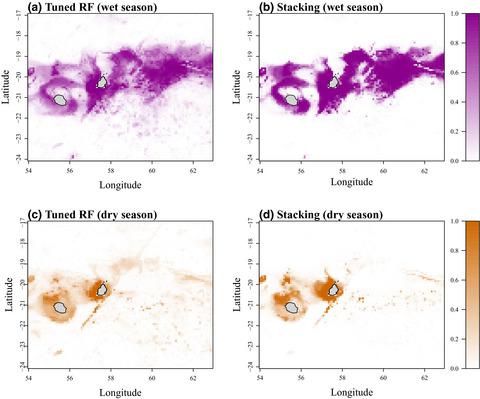当前位置:
X-MOL 学术
›
Ecol. Evol.
›
论文详情
Our official English website, www.x-mol.net, welcomes your
feedback! (Note: you will need to create a separate account there.)
Predicting seasonal movements and distribution of the sperm whale using machine learning algorithms
Ecology and Evolution ( IF 2.3 ) Pub Date : 2021-01-12 , DOI: 10.1002/ece3.7154 Philippine Chambault 1, 2 , Sabrina Fossette 3 , Mads Peter Heide-Jørgensen 1 , Daniel Jouannet 2, 4 , Michel Vély 2
Ecology and Evolution ( IF 2.3 ) Pub Date : 2021-01-12 , DOI: 10.1002/ece3.7154 Philippine Chambault 1, 2 , Sabrina Fossette 3 , Mads Peter Heide-Jørgensen 1 , Daniel Jouannet 2, 4 , Michel Vély 2
Affiliation

|
Implementation of effective conservation planning relies on a robust understanding of the spatiotemporal distribution of the target species. In the marine realm, this is even more challenging for species rarely seen at the sea surface due to their extreme diving behavior like the sperm whales. Our study aims at (a) investigating the seasonal movements, (b) predicting the potential distribution, and (c) assessing the diel vertical behavior of this species in the Mascarene Archipelago in the south‐west Indian Ocean. Using 21 satellite tracks of sperm whales and eight environmental predictors, 14 supervised machine learning algorithms were tested and compared to predict the whales' potential distribution during the wet and dry season, separately. Fourteen of the whales remained in close proximity to Mauritius, while a migratory pattern was evidenced with a synchronized departure for eight females that headed towards Rodrigues Island. The best performing algorithm was the random forest, showing a strong affinity of the whales for sea surface height during the wet season and for bottom temperature during the dry season. A more dispersed distribution was predicted during the wet season, whereas a more restricted distribution to Mauritius and Reunion waters was found during the dry season, probably related to the breeding period. A diel pattern was observed in the diving behavior, likely following the vertical migration of squids. The results of our study fill a knowledge gap regarding seasonal movements and habitat affinities of this vulnerable species, for which a regional IUCN assessment is still missing in the Indian Ocean. Our findings also confirm the great potential of machine learning algorithms in conservation planning and provide highly reproductible tools to support dynamic ocean management.
中文翻译:

使用机器学习算法预测抹香鲸的季节性活动和分布
有效保护规划的实施依赖于对目标物种时空分布的深入了解。在海洋领域,对于像抹香鲸这样的极端潜水行为很少在海面看到的物种来说,这更具挑战性。我们的研究旨在(a)调查季节性运动,(b)预测潜在分布,以及(c)评估西南印度洋马斯克林群岛该物种的昼夜垂直行为。使用 21 个抹香鲸卫星轨迹和 8 个环境预测因子,对 14 种监督机器学习算法进行了测试和比较,以分别预测鲸鱼在雨季和旱季的潜在分布。其中 14 头鲸鱼仍在毛里求斯附近,而 8 头雌性鲸鱼同步离开,前往罗德里格斯岛,这证明了一种迁徙模式。表现最好的算法是随机森林,显示鲸鱼对雨季海面高度和旱季底部温度有很强的亲和力。预计雨季分布更为分散,而旱季分布在毛里求斯和留尼汪岛水域则更为有限,这可能与繁殖期有关。在潜水行为中观察到昼夜模式,可能是在鱿鱼垂直迁移之后。我们的研究结果填补了有关这种脆弱物种的季节性运动和栖息地亲和力的知识空白,印度洋仍然缺乏区域自然保护联盟的评估。 我们的研究结果还证实了机器学习算法在保护规划中的巨大潜力,并提供了高度可重复的工具来支持动态海洋管理。
更新日期:2021-02-05
中文翻译:

使用机器学习算法预测抹香鲸的季节性活动和分布
有效保护规划的实施依赖于对目标物种时空分布的深入了解。在海洋领域,对于像抹香鲸这样的极端潜水行为很少在海面看到的物种来说,这更具挑战性。我们的研究旨在(a)调查季节性运动,(b)预测潜在分布,以及(c)评估西南印度洋马斯克林群岛该物种的昼夜垂直行为。使用 21 个抹香鲸卫星轨迹和 8 个环境预测因子,对 14 种监督机器学习算法进行了测试和比较,以分别预测鲸鱼在雨季和旱季的潜在分布。其中 14 头鲸鱼仍在毛里求斯附近,而 8 头雌性鲸鱼同步离开,前往罗德里格斯岛,这证明了一种迁徙模式。表现最好的算法是随机森林,显示鲸鱼对雨季海面高度和旱季底部温度有很强的亲和力。预计雨季分布更为分散,而旱季分布在毛里求斯和留尼汪岛水域则更为有限,这可能与繁殖期有关。在潜水行为中观察到昼夜模式,可能是在鱿鱼垂直迁移之后。我们的研究结果填补了有关这种脆弱物种的季节性运动和栖息地亲和力的知识空白,印度洋仍然缺乏区域自然保护联盟的评估。 我们的研究结果还证实了机器学习算法在保护规划中的巨大潜力,并提供了高度可重复的工具来支持动态海洋管理。











































 京公网安备 11010802027423号
京公网安备 11010802027423号